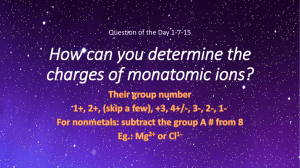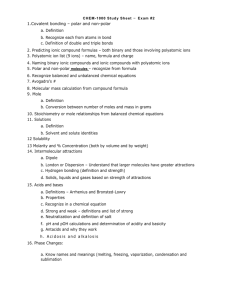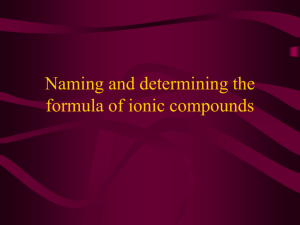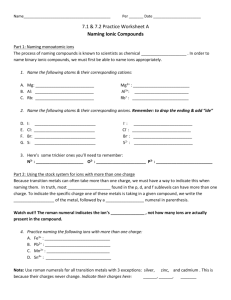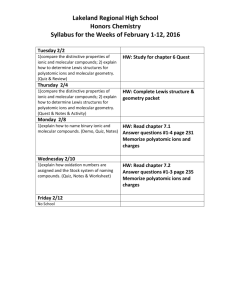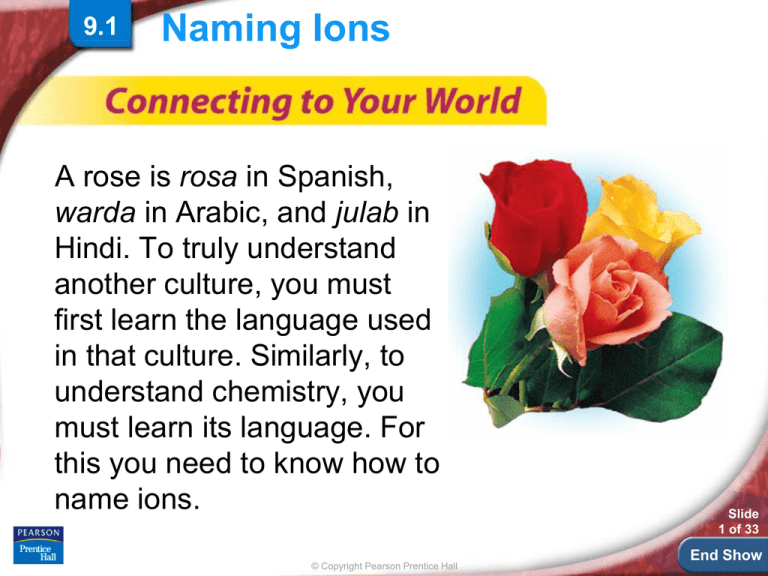
9.1
Naming Ions
A rose is rosa in Spanish,
warda in Arabic, and julab in
Hindi. To truly understand
another culture, you must
first learn the language used
in that culture. Similarly, to
understand chemistry, you
must learn its language. For
this you need to know how to
name ions.
© Copyright Pearson Prentice Hall
Slide
1 of 33
End Show
9.1
Naming Ions
> Monatomic Ions
Monatomic Ions
How are the charges of Group A metal
and nonmetal ions related to their
positions in the periodic table?
Monatomic ions consist of a single atom
with a positive or negative charge
resulting from the loss or gain of one or
more valence electrons, respectively. 2 Slide
of 33
© Copyright Pearson Prentice Hall
End Show
9.1
Naming Ions
> Monatomic Ions
Cations
When the metals in Groups 1, 2, and 13
lose electrons, they form cations with
positive charges equal to their group
number.
The names of the cations of the Group
1, Group 2, and Group 13 metals are the
same as the name of the metal,
followed by the word ion or cation.
Slide
3 of 33
© Copyright Pearson Prentice Hall
End Show
9.1
Naming Ions
> Monatomic Ions
Slide
4 of 33
© Copyright Pearson Prentice Hall
End Show
9.1
Naming Ions
> Monatomic Ions
Ions of Transition Metals
How are the charges of some transition
metal ions determined?
The charges of the cations of many
transition metal ions must be
determined from the number of
electrons lost.
Slide
5 of 33
© Copyright Pearson Prentice Hall
End Show
9.1
Naming Ions
> Monatomic Ions
These colorful solutions contain the transition
metal ions Co3+, Cr3+, Fe3+, Ni2+, and Mn2+.
Slide
6 of 33
© Copyright Pearson Prentice Hall
End Show
9.1
Naming Ions
> Monatomic Ions
Many transition metal
compounds are colored and
can be used as pigments.
Slide
7 of 33
© Copyright Pearson Prentice Hall
End Show
9.1
Naming Ions
> Monatomic Ions
Two methods are used to name the ions of
transition metals.
• The Stock system (this is the one we will use)
• The classical method
Slide
8 of 33
© Copyright Pearson Prentice Hall
End Show
9.1
Naming Ions
> Monatomic Ions
In the Stock system, a Roman numeral in
parentheses is placed after the name of the
element to indicate the numerical value of the
charge.
In an older less, useful method, the classical
name of the element is used to form the root
name for the element.
Slide
9 of 33
© Copyright Pearson Prentice Hall
End Show
9.1
Naming Ions
> Monatomic Ions
Slide
10 of 33
© Copyright Pearson Prentice Hall
End Show
Practice Problems for Conceptual Problem 9.1
Practice Problems For Conceptual Problem 9.1
Problem-Solving 9.1 Solve
Problem 1 with the help of
an interactive guided tutorial.
Slide
11 of 33
© Copyright Pearson Prentice Hall
End Show
9.1
Naming Ions
> Polyatomic Ions
Polyatomic Ions
What are the two endings of the names
of most polyatomic ions?
(Hint: use Table E)
Slide
12 of 33
© Copyright Pearson Prentice Hall
End Show
9.1
Naming Ions
> Polyatomic Ions
These models show the structures of four
common polyatomic ions.
Slide
13 of 33
© Copyright Pearson Prentice Hall
End Show
9.1
Naming Ions
> Polyatomic Ions
Some ions, called polyatomic ions, are
composed of more than one atom.
The names of most polyatomic anions
end in -ite or -ate.
Slide
14 of 33
© Copyright Pearson Prentice Hall
End Show
9.1
Naming Ions
> Polyatomic Ions
Names and Formulas of
Some Common Polyatomic
Ions (see first page of regents
reference tables)
Slide
15 of 33
© Copyright Pearson Prentice Hall
End Show
9.1
Naming Ions
> Polyatomic Ions
Sodium hydrogen carbonate can relieve an
upset stomach.
Slide
16 of 33
© Copyright Pearson Prentice Hall
End Show
9.1
Naming Ions
> Polyatomic Ions
HCO3–, HPO42–, and H2PO4– ions in your blood
are critical for your health.
Slide
17 of 33
© Copyright Pearson Prentice Hall
End Show
9.1
Naming Ions
> Polyatomic Ions
Fertilizers contain HPO42– and H2PO4– ions.
Slide
18 of 33
© Copyright Pearson Prentice Hall
End Show
9.1 Section Quiz.
Assess students’ understanding
of the concepts in Section 9.1.
Continue to:
-or-
Launch:
Section Quiz
Slide
19 of @@
© Copyright Pearson Prentice Hall
End Show
9.1 Section Quiz
2. Which of the following are positively charged
polyatomic ions?
a. (I) ammonium ion
b. (II) perchlorate ion
c. (III) ferric ion = Fe(III) ion
a. I only
b. II only
c. III only
d. I and III
Slide
20 of 33
© Copyright Pearson Prentice Hall
End Show
9.1 Section Quiz
3. If the name of an ion ends in -ite or -ate, the
ion is a
a. polyatomic cation.
b. polyatomic anion.
c. transition metal cation.
d. monatomic anion.
Slide
21 of 33
© Copyright Pearson Prentice Hall
End Show
9.2
Binary Ionic Compounds
Binary Ionic Compounds
a.How are the names of binary ionic
compounds determined?
b.How do you write the formulas for
binary ionic compounds?
Slide
22 of 33
© Copyright Pearson Prentice Hall
End Show
9.2
Binary Ionic Compounds
a. These masks are made of an ionic
compound with the common name
gypsum. This name does not tell you
anything about the chemical composition
of the compound, though.
Slide
23 of 33
© Copyright Pearson Prentice Hall
End Show
9.2
Binary Ionic Compounds
Naming Binary Ionic Compounds
a. A binary compound is composed of two
elements and can be either ionic or
molecular.
a.To name any binary ionic compound,
place the cation name first, followed by
the anion name.
Slide
24 of 33
© Copyright Pearson Prentice Hall
End Show
9.2
Binary Ionic Compounds
a. Tin(II) sulfide, or SnF2, is added to
toothpastes to prevent cavities.
Slide
25 of 33
© Copyright Pearson Prentice Hall
End Show
9.2
Binary Ionic Compounds
a. Tin(IV) sulfide, or SnS2, is used in glazes
for porcelain fixtures and dishes.
Slide
26 of 33
© Copyright Pearson Prentice Hall
End Show
9.2
Binary Ionic Compounds
a. Hematite, a common ore of iron, contains
iron (III) oxide. The balanced formula is
Fe2O3.
Slide
27 of 33
© Copyright Pearson Prentice Hall
End Show
9.2
Binary Ionic Compounds
Writing Formulas for Binary Ionic Compounds
a.Write the symbol of the cation and
then the anion. Add whatever subscripts
are needed to balance the charges.
Slide
28 of 33
© Copyright Pearson Prentice Hall
End Show
9.2
Conceptual Problem 9.2
Slide
29 of 33
© Copyright Pearson Prentice Hall
End Show
9.2
Conceptual Problem 9.2
Slide
30 of 33
© Copyright Pearson Prentice Hall
End Show
9.2
Conceptual Problem 9.2
Slide
31 of 33
© Copyright Pearson Prentice Hall
End Show
for Conceptual Problem 9.2
Sample Problems For Conceptual Problem
9.2
Problem Solving 9.11 Solve Problem
11 with the help of an interactive
guided tutorial.
Slide
32 of 33
© Copyright Pearson Prentice Hall
End Show
9.2
Compounds With Polyatomic Ions
Compounds with Polyatomic Ions
How do you write the formulas and names of
compounds containing polyatomic ions?
Write the symbol for the cation followed by the
formula for the polyatomic ion and balance
the charges.
Slide
33 of 33
© Copyright Pearson Prentice Hall
End Show
9.2
Compounds With Polyatomic Ions
a. For example, calcium nitrate is composed
of a calcium cation (Ca2+) and a polyatomic
nitrate anion (NO3–).
b. In calcium nitrate, two nitrate anions, each
with a 1– charge, are needed to balance
the 2+ charge of each calcium cation. The
formula for calcium nitrate is Ca(NO3)2.
Slide
34 of 33
© Copyright Pearson Prentice Hall
End Show
9.2
Compounds With Polyatomic Ions
a. Oysters produce calcium carbonate to form
their shells and sometimes pearls.
Slide
35 of 33
© Copyright Pearson Prentice Hall
End Show
9.2
Compounds With Polyatomic Ions
a. Lead(II)sulfate is an important component
of an automobile battery.
Slide
36 of 33
© Copyright Pearson Prentice Hall
End Show
9.3
Conceptual Problem 9.3
Slide
37 of 33
© Copyright Pearson Prentice Hall
End Show
9.3
Conceptual Problem 9.3
Slide
38 of 33
© Copyright Pearson Prentice Hall
End Show
9.3
Conceptual Problem 9.3
Slide
39 of 33
© Copyright Pearson Prentice Hall
End Show
for Conceptual Problem 9.3
Practice Problems For Conceptual Problem
9.3
Problem-Solving 9.12 Solve Problem
12 with the help of an interactive
guided tutorial.
Slide
40 of 33
© Copyright Pearson Prentice Hall
End Show
9.2
Compounds With Polyatomic Ions
Naming Compounds with Polyatomic Ions
a.To name a compound containing a
polyatomic ion, state the cation first and
then the anion, just as you did in
naming binary ionic compounds.
Slide
41 of 33
© Copyright Pearson Prentice Hall
End Show
9.2
Compounds With Polyatomic Ions
a. Sodium
hypochlorite
(NaClO) is used as
a disinfectant for
swimming pools.
The metallic cation
in this compound
is sodium (Na+) so
the polyatomic ion
must be ClO–.
Slide
42 of 33
© Copyright Pearson Prentice Hall
End Show
9.2 section Quiz.
Assess students’ understanding of the
concepts in Section 9.2.
Slide
43 of 33
© Copyright Pearson Prentice Hall
End Show
9.2 Section Quiz
1. The correct name for CrCl3 is
a. chromium chlorine.
b. chromium(III) chloride.
c. monochromium trichloride.
d. chromium(III) trichloride.
Slide
44 of 33
© Copyright Pearson Prentice Hall
End Show
9.2 Section Quiz
2. What is the correct formula for strontium
nitride?
a. Sr3N2
b. SrN2
c. Sr2N3
d. Sr3N
Slide
45 of 33
© Copyright Pearson Prentice Hall
End Show
9.2 Section Quiz
3. Which one of the following compounds is
named correctly?
a. sodium chlorite, NaClO
b. potassium nitrate, KNO2
c. sodium acetate, NaC2H3O2
d. lithium sulfate, Li2SO3
Slide
46 of 33
© Copyright Pearson Prentice Hall
End Show

